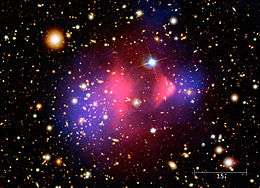Cuspy halo problem
The cuspy halo problem (also known as the core-cusp problem) refers to a discrepancy between the observed dark matter density profiles of low-mass galaxies and the density profiles predicted by cosmological N-body simulations. Nearly all simulations form dark matter halos which have "cuspy" dark matter distributions, with density increasing steeply at small radii, while the rotation curves of most observed dwarf galaxies suggest that they have flat central dark matter density profiles ("cores").[1][2]
Several possible solutions to the core-cusp problem have been proposed. Many recent studies have shown that including baryonic feedback (particularly feedback from supernovae and active galactic nuclei) can "flatten out" the core of a galaxy's dark matter profile, since feedback-driven gas outflows produce a time-varying gravitational potential that transfers energy to the orbits of the collisionless dark matter particles.[3][4] Other works have shown that the core-cusp problem can be solved outside of the most widely accepted Cold Dark Matter (CDM) paradigm: simulations with warm or self-interacting dark matter also produce dark matter cores in low-mass galaxies.[5][6]
Simulation results
"The presence of a cusp in the centers of CDM halos is one of the earliest and strongest results derived from N-body cosmological simulations."[7] Numerical simulations for CDM structure formation predict some structure properties that conflict with astronomical observations.
Observations
The discrepancies range from galaxies to clusters of galaxies. "The main one that has attracted a lot of attention is the cuspy halo problem, namely that CDM models predict halos that have a high density core or have an inner profile that is too steep compared to observations."[8]
Potential solutions
The conflict between numerical simulations and astronomical observations creates numerical constraints related to the core/cusp problem. Observational constraints on halo concentrations imply the existence of theoretical constraints on cosmological parameters. According to McGaugh, Barker, and de Blok,[9] there might be 3 basic possibilities for interpreting the halo concentration limits stated by them or anyone else:
- "CDM halos must have cusps, so the stated limits hold and provide new constraints on cosmological parameters."[10]
- "Something (e.g. feedback, modifications of the nature of dark matter) eliminates cusps and thus the constraints on cosmology."[11]
- "The picture of halo formation suggested by CDM simulations is wrong."
One approach to solving the cusp-core problem in galactic halos is to consider models that modify the nature of dark matter; theorists have considered warm, fuzzy, self-interacting, and meta-cold dark matter, among other possibilities.[12]
References
- ↑ Moore, Ben; et al. (August 1994). "Evidence against dissipation-less dark matter from observations of galaxy haloes". Nature. 370 (6491): 629–631. Bibcode:1994Natur.370..629M. doi:10.1038/370629a0.
- ↑ Oh, Se-Heon; et al. (May 2015). "High-resolution Mass Models of Dwarf Galaxies from LITTLE THINGS". The Astronomical Journal. 149 (6): 180. arXiv:1502.01281
 . Bibcode:2015AJ....149..180O. doi:10.1088/0004-6256/149/6/180.
. Bibcode:2015AJ....149..180O. doi:10.1088/0004-6256/149/6/180. - ↑ Navarro, Julio; et al. (December 1996). "The cores of dwarf galaxy haloes". MNRAS. 283 (3): L72–L78. arXiv:astro-ph/9610187
 . Bibcode:1996MNRAS.283L..72N. doi:10.1093/mnras/283.3.72L.
. Bibcode:1996MNRAS.283L..72N. doi:10.1093/mnras/283.3.72L. - ↑ Pontzen, Andrew; et al. (2012). "How supernova feedback turns dark matter cusps into cores". Nature. 421 (4): 3464–3471. arXiv:1106.0499
 . Bibcode:2012MNRAS.421.3464P. doi:10.1111/j.1365-2966.2012.20571.x.
. Bibcode:2012MNRAS.421.3464P. doi:10.1111/j.1365-2966.2012.20571.x. - ↑ Lovell, Mark; et al. (March 2012). "The haloes of bright satellite galaxies in a warm dark matter universe". MNRAS. 420 (3): 2318–2324. arXiv:1104.2929
 . Bibcode:2012MNRAS.420.2318L. doi:10.1111/j.1365-2966.2011.20200.x.
. Bibcode:2012MNRAS.420.2318L. doi:10.1111/j.1365-2966.2011.20200.x. - ↑ Elbert, Oliver; et al. (October 2015). "Core formation in dwarf haloes with self-interacting dark matter: no fine-tuning necessary". MNRAS. 453 (1): 29–37. arXiv:1412.1477
 . Bibcode:2015MNRAS.453...29E. doi:10.1093/mnras/stv1470.
. Bibcode:2015MNRAS.453...29E. doi:10.1093/mnras/stv1470. - ↑ de Blok; W. J. G. (2009). "The core-cusp problem". arXiv:0910.3538
 . Bibcode:2010AdAst2010E...5D. doi:10.1155/2010/789293.
. Bibcode:2010AdAst2010E...5D. doi:10.1155/2010/789293. - ↑ Hui, L. (2001). "Unitarity Bounds and the Cuspy Halo Problem". Phys. Rev. Lett. 86: 3467–3470. arXiv:astro-ph/0102349
 . Bibcode:2001PhRvL..86.3467H. doi:10.1103/PhysRevLett.86.3467.
. Bibcode:2001PhRvL..86.3467H. doi:10.1103/PhysRevLett.86.3467. - ↑ McGaugh, S.S.; Barker, M.K.; de Blok, W.J.G. (Feb 20, 2003). "A limit on the cosmological mass density and power spectrum from the rotation curves of low surface brightness galaxies". The Astrophysical Journal. 584: 566–576. arXiv:astro-ph/0210641
 . Bibcode:2003ApJ...584..566M. doi:10.1086/345806.
. Bibcode:2003ApJ...584..566M. doi:10.1086/345806. - ↑ Valenzuela, O.; Rhee, G.; Klypin, A.; Governato, F.,Stinson, G.; Quinn, T.; Wadsley, J. (Feb 20, 2007). "Is There Evidence for Flat Cores in the Halos of Dwarf Galaxies? The Case of NGC 3109 and NGC 6822". The Astrophysical Journal. 657: 773–789. arXiv:astro-ph/0509644
 . Bibcode:2007ApJ...657..773V. doi:10.1086/508674.
. Bibcode:2007ApJ...657..773V. doi:10.1086/508674. - ↑ Governato, F.; Brook, C.; Mayer, L.; Brooks, A.,Rhee, G.; Jonsson, P.; Willman, B.; Stinson, G.; Quinn, T.; Madau, P. (Jan 20, 2010). "Bulgeless dwarf galaxies and dark matter cores from supernova-driven outflows". Nature. 463: 203–206. arXiv:0911.2237
 . Bibcode:2010Natur.463..203G. doi:10.1038/nature08640.
. Bibcode:2010Natur.463..203G. doi:10.1038/nature08640. - ↑ McGaugh, S.S.; de Blok, W.J.G.; Schombert, J.M.; Kuzio de Naray, R.; Kim, J.H. (April 10, 2007). "The rotation velocity attributable to dark matter at intermediate radii in disk galaxies". The Astrophysical Journal. 659: 149–161. arXiv:astro-ph/0612410
 . Bibcode:2007ApJ...659..149M. doi:10.1086/511807.
. Bibcode:2007ApJ...659..149M. doi:10.1086/511807.
See also
- Dwarf galaxy problem (also known as "the missing satellites problem")
- List of unsolved problems in physics
